
Date: Saturday, November 7, 2015
Project: Eastern Australian Waterbird Survey
Observer: Richard Kingsford
Mist and low cloud greeted us when we set off early back to Sydney. First survey was to repeat our hour and half or so along the River Murray from Berri to Wentworth. These repeats give us some measure of error and variability for our surveys.
Near Berri – there was a colony of Australian white ibis and straw-necked ibis. This has been a bit of surprise in this dry year, to pick up these colonies on the River Murray.
Ibis colony on the River Murray, near Berri
There are a few lakes away from the river with high densities of waterbirds but the main channel only has the odd pelican and cormorant as houseboats go up and down the river.
River Murray downstream of the town of Wentworth, showing one of the houseboats.
We refuelled at Mildura and then set off back to Sydney. We had finished our River Murray survey for 2015. On the way back, we checked on reports that ibis were collecting on the Lowbidgee, part of the Murrumbidgee River, near Balranald. This massive system was bought back by governments with its water in the last few years and represents a fantastic opportunity to manage environmental flows to one of the most important wetlands in the Murray-Darling Basin. Delivery of environmental flows had triggered trampling of lignum bushes and nesting by straw-necked ibis and Australian white ibis a prelude to nesting on the Telephone Bank, part of one of the major wetlands of this system.
Flooding of the Telephone bank swamp with environmental flows was attracting waterbirds, including ibis to start their breeding.
Further to the east, the environmental flows in Eulimbah Swamp had started a small colony where parents were already incubating eggs.
